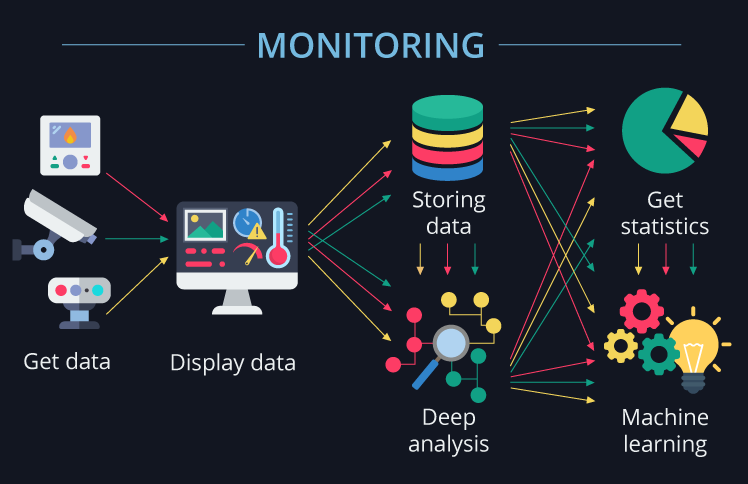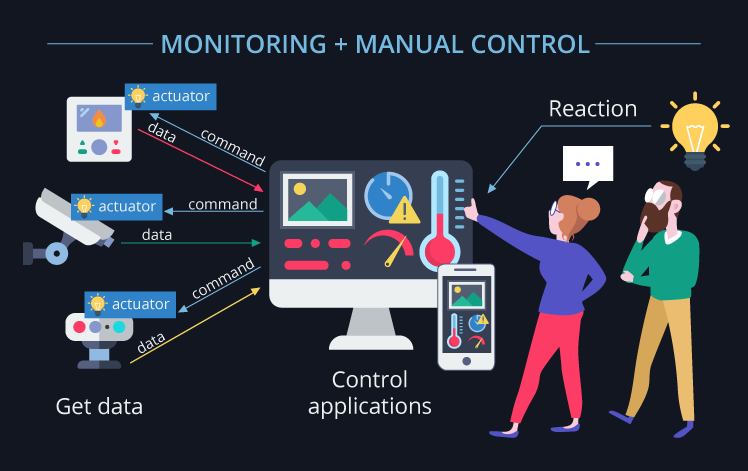IoT systems classification with examples
Considering the variety of IoT systems, it can be difficult for business players to decide what they really need. The number of IoT solutions is increasing at quite an impressive pace, and these systems are designed to perform various functions.
Basing on our experience in IoT development, we want to bring more clarity to this variety and introduce our approach to the IoT systems classification.

IoT solutions for monitoring
With the help of sensor data, a user of a smart, connected thing can monitor its real-time state and environment. In a longer-term perspective, the results of monitoring can be gathered and applied for advanced insights.
Accumulated sensor data helps to get detailed and meaningful statistics, assess the performance of equipment from different perspectives, uncover new patterns and tendencies and more. Monitoring is important assistance in proactive maintenance as IoT system users get an opportunity to identify the problems before the damage is done and take necessary measures.

Storing data and showing to users
Connected devices can give an expanded picture of patients’ health, environmental conditions, equipment state in factories and power plants, help users monitor their pets, cars, homes and more. Remote monitoring of facilities, processes and events brings better operational insights: sensors can gather the data that helps to see and assess real-time state of smart connected things.
Let’s take a smart railway as an example. Trains can be equipped with sensors that take the data about real-time status of the parts of a train and enable the IoT system users to monitor the state of breaks, wheels and engines. The results can be viewed by a train driver, traffic superintendent or any other responsible person as well as collected for further analysis.
In subway trains, big data can be used to measure passenger flow and identify the hours and days when additional trains are needed. Another case (when the solutions are designed not only for the monitoring) is adding a new train to the route if many passengers are waiting (for example, trains come every 20 minutes, but when the platform is getting overcrowded, additional trains are provided).
Deep analysis and detection of specific situations
An IoT system can not only take and display sensor data (for example, temperature or humidity), but also make conclusions about what certain values of data could mean.
Processing the data coming from sensors, an IoT system can not only detect anomalies, but also predict operational malfunctioning and point at the root causes of problems. Thus, comparing current data coming from sensors and the data stored in the cloud as acceptable values, an IoT solution monitoring trains and railways can show that a certain part is about to be out of order. The historical data about the conditions of using trains and the breakdowns that happen can help identify (and then – predict) the conditions leading to failures.
IoT solutions for monitoring with manual control
In many cases, the potential of the Internet of things can bring far more value than just improved monitoring. Thus, a user of an IoT system can give commands to the connected things and enable them to perform certain operations.

Let's take a case when a user receives the results of monitoring and some response is needed. Theoretically, a smart system can tackle certain issues even without human participation, but not always. In some cases, machines are incapable to perform required operations, in the others – the issues cannot be trusted to machines (for example, replacing a broken detail).
Manual control is a good solution to be on the safe side in the situations an IoT system didn’t face before. With unfamiliar incoming data, it can be better to let humans make final decisions. An IoT system can, for example, give recommendations – and people decide whether to follow them or not. In the longer term, the data about user actions in response to certain sensor data can be used by machine learning module to make models for control applications and contribute to further automation of a system.
IoT solutions for monitoring with automated control
In IoT systems with automated control, control applications send commands to actuators. The choice of the commands to be sent depends on the data coming from sensors and/or previously defined schedules.
Rule-based control
An IoT system with rule-based control is designed to act in accordance with the algorithms featuring what should be done in response to certain data coming from sensors. Rules are stated before the system is put into action.
In freight trains, sensors can measure temperature, vibrations and other parameters critical for cargo. This big data goes to the cloud, and, when the smart system identifies that some parameters differ from acceptable values, control applications send commands to adjust these parameters (for example, increase or decrease refrigerating).
In such freight trains, it’s also possible to set acceptable values in different carriages before the trip begins (as soon as various goods can be transported in different cars and each type of transported goods requires corresponding conditions).

Machine learning-based control
The next stage of IoT systems evolution is the systems with machine-learning based control when IoT potential is used to its fullest extent. In machine learning, sensor data is continuously collected and regularly used in standard machine learning algorithms. New models are generated, and their applicability is then tested by analysts and / or data scientists. When the models are approved, they can be used by an IoT system.
In a smart railway, such learning can be performed with analyzing human commands. The responses of humans to certain sensor data are accumulated in a big data warehouse, and then the models of how to act are built accordingly (considering the actions of humans in certain situations).
Cameras can take photos of potential problems (suspicions that there are some problems) and send them for further analysis (either manually or with computer assistance). As soon as various images are collected in the cloud (and the problems are identified), smart systems “learn” to determine the types of problems without human participation and send corresponding notifications.
Machine learning potential can contribute to optimizing subway trains’ schedules. Smart system accommodates the data about the passenger flow on different days and at different times of the day. Then, it defines the days and the time slots when additional trains should be put on the line, and, thus, offers schedule optimizations.
It makes sense to notice that, even if an IoT solution can, in most cases, successfully operate without human participation, there should be an option of manual control.
Endnote
To sum it up, IoT systems can be classified in the following way:
-
Solutions for monitoring: sensor data helps monitor the state and environment of smart connected things. In this case, IoT solutions can perform storing data and showing it to users. Also, the data gathered with sensors can be analyzed and used for detecting specific situations.
-
Monitoring + manual control: with user apps, users are empowered to give the commands to connected things’ actuators and control the processes in an IoT system.
-
Monitoring + automated control: control apps automatically send the commands to actuators, and human participation in controlling an IoT system is significantly reduced. Automated control can be performed on the basis of the previously defined rules (rule-based control). With machine learning, IoT systems can adapt to user behavior and changing environment and “learn” how to perform operations in more productive ways. However, it’s reasonable to enable the shift from automated to manual control over IoT solution’s operation as no IoT system is immune to breakdowns and unpredicted situations.
An organization needs to clearly realize what it expects from the Internet of Things and which types of IoT solution will help to cover current and future business needs. The exploration of the IoT path should begin with the great deal of business and IT strategy planning.

